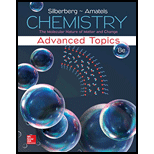
(a)
Interpretation:
The types of atomic orbitals of the central atom that are mixed to form hybrid orbitals in
Concept introduction:
The atomic orbitals are the regions around the nucleus of the atom where the electron can be found. These allow atoms to form covalent bonds. There are four types of atomic orbitals. These are
The atomic orbitals mix with each other and form hybrid orbitals. These are used in the formation of covalent bonds. These orbitals are more stable than the atomic orbitals from which they are made up.
(b)
Interpretation:
The types of atomic orbitals of the central atom that are mixed to form hybrid orbitals in
Concept introduction:
The atomic orbitals are the regions around the nucleus of the atom where the electron can be found. These allow atoms to form covalent bonds. There are four types of atomic orbitals. These are
The atomic orbitals mix with each other and form hybrid orbitals. These are used in the formation of covalent bonds. These orbitals are more stable than the atomic orbitals from which they are made up.
(c)
Interpretation:
The types of atomic orbitals of the central atom that are mixed to form hybrid orbitals in
Concept introduction:
The atomic orbitals are the regions around the nucleus of the atom where the electron can be found. These allow atoms to form covalent bonds. There are four types of atomic orbitals. These are
The atomic orbitals mix with each other and form hybrid orbitals. These are used in the formation of covalent bonds. These orbitals are more stable than the atomic orbitals from which they are made up.
(d)
Interpretation:
The types of atomic orbitals of the central atom that are mixed to form hybrid orbitals in
Concept introduction:
The atomic orbitals are the regions around the nucleus of the atom where the electron can be found. These allow atoms to form covalent bonds. There are four types of atomic orbitals. These are
The atomic orbitals mix with each other and form hybrid orbitals. These are used in the formation of covalent bonds. These orbitals are more stable than the atomic orbitals from which they are made up.
Want to see the full answer?
Check out a sample textbook solution
Chapter 11 Solutions
Student Solutions Manual For Silberberg Chemistry: The Molecular Nature Of Matter And Change With Advanced Topics
- Draw the mechanism for the formation of diol by starting with one pen and all in... basic conditions then acidic conditions then draw the mechanism for the formation of a carboxylic acid from your product.arrow_forwardDraw the mechanism for the oxidation of 3-bromo-cyclohexan-1-ol.arrow_forwardConvert the following Fischer projection to Haworth projections. show work and show the arrows please.arrow_forward
- Draw the mechanism for the substitution reaction converting an alcohol into an alkyl halide. If chirality is important to the reaction include it.arrow_forwardWrite, in words three different reactions we can use to make an alcohol.arrow_forwardDraw the reduction mechanism for the reduction of the aldehyde.arrow_forward
 ChemistryChemistryISBN:9781305957404Author:Steven S. Zumdahl, Susan A. Zumdahl, Donald J. DeCostePublisher:Cengage Learning
ChemistryChemistryISBN:9781305957404Author:Steven S. Zumdahl, Susan A. Zumdahl, Donald J. DeCostePublisher:Cengage Learning ChemistryChemistryISBN:9781259911156Author:Raymond Chang Dr., Jason Overby ProfessorPublisher:McGraw-Hill Education
ChemistryChemistryISBN:9781259911156Author:Raymond Chang Dr., Jason Overby ProfessorPublisher:McGraw-Hill Education Principles of Instrumental AnalysisChemistryISBN:9781305577213Author:Douglas A. Skoog, F. James Holler, Stanley R. CrouchPublisher:Cengage Learning
Principles of Instrumental AnalysisChemistryISBN:9781305577213Author:Douglas A. Skoog, F. James Holler, Stanley R. CrouchPublisher:Cengage Learning Organic ChemistryChemistryISBN:9780078021558Author:Janice Gorzynski Smith Dr.Publisher:McGraw-Hill Education
Organic ChemistryChemistryISBN:9780078021558Author:Janice Gorzynski Smith Dr.Publisher:McGraw-Hill Education Chemistry: Principles and ReactionsChemistryISBN:9781305079373Author:William L. Masterton, Cecile N. HurleyPublisher:Cengage Learning
Chemistry: Principles and ReactionsChemistryISBN:9781305079373Author:William L. Masterton, Cecile N. HurleyPublisher:Cengage Learning Elementary Principles of Chemical Processes, Bind...ChemistryISBN:9781118431221Author:Richard M. Felder, Ronald W. Rousseau, Lisa G. BullardPublisher:WILEY
Elementary Principles of Chemical Processes, Bind...ChemistryISBN:9781118431221Author:Richard M. Felder, Ronald W. Rousseau, Lisa G. BullardPublisher:WILEY





